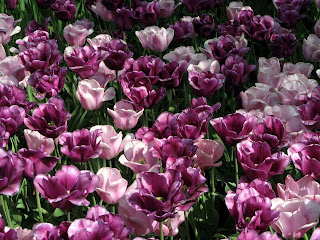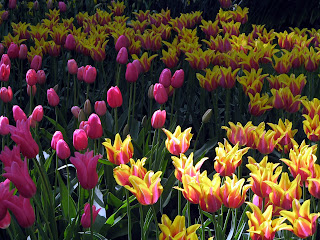 Vermeer, Girl with Pearl Earring, 1665 (Mauritshuis, The Hague)[click on images to enhance viewing]JAN VERMEER, PAINTER OF DELFT
Vermeer, Girl with Pearl Earring, 1665 (Mauritshuis, The Hague)[click on images to enhance viewing]JAN VERMEER, PAINTER OF DELFT Vermeer’s View of Delft, 1660-64 (Mauritshuis, The Hague)
Vermeer’s View of Delft, 1660-64 (Mauritshuis, The Hague)In my blog entry of June 24, 2010, I wrote:
“The three great painters of the Dutch Golden Age succeed each other in such a way as to define the three periods of its history. Frans Hals (1583-1666), Rembrandt van Rijn (1606-1669), and Johannes Vermeer (1632-1675), each of them characterizes a unique phase in that Golden Age: the forthright rebelliousness of Hals, the classic monumentality of Rembrandt, and the soft and balanced maturity and refinement of Vermeer. But the proximity of their deaths, all within nine years of one another, is a symbolic foreshortening of the Golden Age, and an illustration of its relative brevity. That brief moment in the cultural history of the northern Netherlands, illuminated by its painters against the dark background of the religious war against Spanish Catholic hegemony, as well as against the dark background of its own Calvinistic faith, can be said to begin in the city of Haarlem because of the paintings of Frans Hals, its native son. Haarlem is the city of Frans Hals, and Hals is the painter of Haarlem.”
Vermeer is the painter of Delft. He was born and died there, and his 1664 painting of the city,
View of Delft, (above), now at the Mauritshuis in The Hague, is very well-known. The city of Delft has appropriated him. The house of the old St. Lucas Gilde [Guild] of painters, located on the Voldersgracht near the center of the old town, is now a Vermeer museum.

It displays none of his works, which are housed primarily in the Rijksmuseum of Amsterdam and the Mauritshuis in The Hague, although there are various in the National Gallery of Art in Washington and the Metropolitan in New York, as well as in other collections. The Vermeer Centrum in Delft tries instead to show the look of the painter’s atelier, the manner and place of his work, the color of his paintings. It is by and large a disappointment.
Tomb of Vermeer in the Old Church of Delft
It is disturbing to think that the remains of the great craftsman, a man of such clarity of vision and of such manifest capacity to appreciate beauty and color, lie underneath this.

 Tower of the Old Church (Oude Kerk) in Delft
Tower of the Old Church (Oude Kerk) in Delft,
as seen from the Prinsenhof Canal next to the Old Church
Canal next to the Old ChurchThe city itself still retains some of that quality that is visible in the few urban scenes that Vermeer painted. The little street in the painting Street in Delft (below), from 1657-58, now at the Rijkmuseum in Amsterdam, is not too dissimilar from what can still be seen there now.
 Street in Delft, 1657-58 (Rijksmuseum in Amsterdam)
Street in Delft, 1657-58 (Rijksmuseum in Amsterdam)

 VERMEER AS THE "LAST" PAINTER OF THE DUTCH GOLDEN AGE
VERMEER AS THE "LAST" PAINTER OF THE DUTCH GOLDEN AGEWhereas Rembrandt expresses turmoil in his work, and Hals exhuberance, Vermeer is the painter of the established Golden Age of Holland, an age of Empire and great wealth. His work is accordingly very refined, calm and static. Nothing seems to move much in his paintings. And Holland seems to have withdrawn mostly indoors. Vermeer’s paintings look at the world from no further than the edge of his city, and the great majority of them are domestic genre scenes.
 Lady with her Maidservant, 1667-68 (Frick Collection, New York)
Lady with her Maidservant, 1667-68 (Frick Collection, New York)Genre paintings are those works that depict, in this particular medium, pictorial representations of scenes or events from everyday life. Such representations may be realistic, imagined, or romanticized by the artist. Vermeer was a genre painter.
 The Love Letter, 1664-70 (Rijksmuseum, Amsterdam)H.W. Hanson
The Love Letter, 1664-70 (Rijksmuseum, Amsterdam)H.W. Hanson has this to say about Vermeer:
"In the genre scenes of Jan Vermeer there is hardly any narrative, by contrast to Jan Steen for example. Single figures, usually women, engage in simple, everyday tasks; when there are two, as in
The Letter (below), they do no more than exchange glances. They exist in a timeless “still life” world, seemingly calmed by some magic spell. The cool clear light that filters in from the left is the only active element, working its miracles upon all the objects in its path.”

The Letter, 1662-64 (Rijksmuseum, Amsterdam)“As we look at
The Letter, we feel as if a veil had been pulled from our eyes; the everyday world shines with jewel-like freshness, beautiful as we have never seen it before. No painter since Jan van Eyck saw as intensely as this. But Vermeer, unlike his predecessors, perceives reality as a mosaic of colored surfaces –or perhaps more accurately, he translates reality into a mosaic as he puts it on canvas. We see
The Letter as a perspective “window,” but also as a plane, a “field” composed of smaller fields. Rectangles predominate, carefully aligned with the picture surface, and there are no “holes,” no undefined empty spaces. These interlocking shapes give to Vermeer’s work a uniquely modern quality within seventeenth century art. How did he acquire it? We know very little about him except that he was born in Delft in 1632 and lived and worked there until his death at forty-three, in 1675. Some of his works show the influence of Carel Fabritius, the most brilliant of Rembrandt’s pupils; other pictures suggest his contact with the Utrecht school. But none of this really explains the genesis of his style, so daringly original that his genius was not recognized until a century ago.” (H. W. Janson,
History of Art, N.Y. 1971, p. 431)
 Girl with Red Hat, 1666-67 (National Gallery of Art, Washington D.C.)
Girl with Red Hat, 1666-67 (National Gallery of Art, Washington D.C.)

 1629, Mauritshuis, The Hague
1629, Mauritshuis, The Hague 1629, Alte Pinakothek, Munich
1629, Alte Pinakothek, Munich 1630, Rijkmuseum, Amsterdam
1630, Rijkmuseum, Amsterdam 1630, Rijkmuseum, Amsterdam
1630, Rijkmuseum, Amsterdam 1630, Rijkmuseum, Amsterdam
1630, Rijkmuseum, Amsterdam 1633, Louvre, Paris
1633, Louvre, Paris 1634, Uffizzi, Florence
1634, Uffizzi, Florence 1634, Alte Gallerie, Berlin
1634, Alte Gallerie, Berlin 1635, Zwinger, Dresden (with Saskia)
1635, Zwinger, Dresden (with Saskia)
 1636-38, Norton Simon, Pasadena
1636-38, Norton Simon, Pasadena 1640, National Gallery, London
1640, National Gallery, London 1650, National Gallery, London
1650, National Gallery, London 1656-58, Kunsthistorisches Museum, Vienna
1656-58, Kunsthistorisches Museum, Vienna 1657, Zwinger, Dresden
1657, Zwinger, Dresden 1659, National Gallery, Washington D.C.
1659, National Gallery, Washington D.C. 1658, Frick Collection, New York
1658, Frick Collection, New York 1660, Louvre, Paris
1660, Louvre, Paris 1660. Metropolitan Museum of Art, New York
1660. Metropolitan Museum of Art, New York 1661, Kenwood House, UK
1661, Kenwood House, UK 1661, Rijksmuseum, Amsterdam
1661, Rijksmuseum, Amsterdam 1668, Wallraf-Richartz, Koln
1668, Wallraf-Richartz, Koln 1669, Mauritshuis, The Hague
1669, Mauritshuis, The Hague 1669, National Gallery, London
1669, National Gallery, London













































